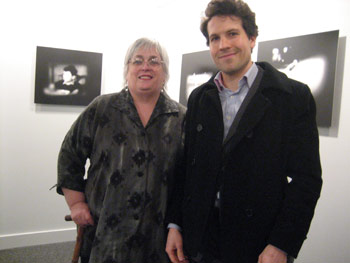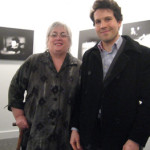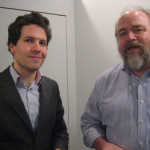By CHARLES GIULIANO
It is tough for Arlette Kayafas to get around. She has been trying to find the time in a busy schedule to have an operation on her knees that will take four months of rehabilitation. So Arlette warned me that she is a bit slow. Turns out I'm no rabbit either. Accordingly we found our pace and world view in perfect synch recently when I picked her up in front of the South End gallery and drove to the garage under the New England School of Art & Design. She was gracious in offering to view my retrospective exhibition and to make some wonderfully insightful comments about the work.
From there we moved down to the atrium of the building which houses one of Boston's best kept secrets. We picked up lunch from the Davio's takeout stand, which is popular with the office workers in the area. It is a delightful space and the location of many of my meetings with artists in planning exhibitions and projects. Best of all, there is no pressure on how long you can take up a table as we talked for a couple of hours. It proved to be a remarkably informative and poignant dialogue. Much of it focused on her relationship with her husband Gus, a fine art photography printer.
When they both turned 60 recently they sponsored a 120th birthday party for about 180 of their friends. To say that they were high school sweethearts is a bit of an understatement. During the first day of high school Arlette spotted Gus and told her best friend "I'm going to marry him and you're going to be my maid of honor." Of course it took a bit of persuading to get Gus on board with the plan. Very soon in the relationship, despite both being strong, independent and opinionated, they quickly became "best friends." They were married at 20 with the approval of parents but she is quick to say that she would not recommend it to her own two sons, one of whom is married. "You wake up at 30 and say who is this person?" she said, but the kids, passion and intuition prevailed.
She describes Gus as very smart and that he knows more about photography than anybody in New England. He started at MIT as a physics major but ran into Minor White and Harold "Doc" Edgerton, a scientist who developed photographic applications of strobe light. Through their influence Gus focused on photography and eventually printed for them, as he later did with Harry Callahan, Aaron Siskind and many others. "Do you remember those big prints of Bill T. Jones and the fashion models in the Herb Ritts show at the MFA?" she asked. "Gus printed them."
From the beginning when Gus worked with those now legendary photographers, he made deals that included some cash and the balance in prints. Of course, back then, the work was not that expensive or valuable while today it is worth a fortune. In some instances they have four and five prints or portfolios of very important images by major artists. Working with "Doc" Edgerton, for example, the prints in his estate all went to museums and they have the only sets available for sale. In recent years they have sold from the collection but very selectively. They have also donated some 1,000 prints to museums. "We have donated to the Getty; MFA; Museum of Modern Art, New York; Amon Carter in Texas; High Museum in Atlanta; Metropolitan Museum in New York; MEP in Paris, and others," she said. They have a special relationship with the DeCordova Museum and Sculpture Park and launched their photography collection with a donation of 400 pieces.
Five years ago Arlette decided to open a gallery. Meeting with several friends she recalled how each had a very good reason why she should not even try. "At the time, I was working assisting elderly women and my client died," she recalled. "Several of her friends were inquiring whether I would then work with them. But I decided that I didn't want to be sad anymore. I did what they are always telling women to do. I sat down and made a list of what interested me and what I wanted to do. Art and photography kept coming up on the top of the list. I discussed it with my oldest son, Peter, (a photographer who lives in Manhattan and is director of Eakins Press Foundation) and stated that I am 55 and starting a gallery. His response was 'Mom, so what do you want to do? Are you going to wait until you are 65?' Not knowing anything about business I opened the gallery which was immediately a triumph. The very fact that I did it."
Right away, she felt a sense of camaraderie with fellow gallerists, especially Howard Yezerski. Randy Hopkins and Beth Kantowitz of Allston Skirt, neighbors in the South End galleries, were encouraging and supplied her with their press list. Eventually, after renovation, she moved down to the basement level of the complex which provides individual entrances to the galleries and she is next to Allston Skirt and Camilo Alvarez of Samson Projects. "I liked the fact that you don't have to go down the hall past several other galleries to reach me." There is competition but also a lot of mutual support. Other than raising their kids she describes the past four years as the happiest and most fulfilling of her life. Having started four years ago, the past two the gallery has run in the black, which is excellent for any new business let alone a gallery.
But a lot of the pleasure has come from being independent and finding her own identity. She described how a lot of their friends assumed that it would be Gus's gallery and that she would be working for him. Initially, when thinking of a name, she considered Gallery Arlette which would have a nice French flair. Her maiden name is Whetzel. But she settled on Gallery Kayafas because of the obvious branding of his reputation in the photo world. While they do sell from the collection, that is really his domain, and she makes the decisions regarding artists shown in the gallery. There are some 45 artists on the website but about a dozen that she primarily works with. There is an annual group show as well as an exhibition that is not photo-based. In addition to photography, they also collect painting and sculpture. Over the past four years there have been two shows drawn from classic works in the collection: Aaron Siskind and Doc Edgerton. "But the shows didn't sell well because the prices were too high," she recalled. At the time I wrote about the Siskind show as a 'museum level' exhibition.
When she started the gallery they took an apartment within walking distance in the South End. Currently they are renovating their modest house in Concord to make it available as rental property. As compulsive collectors, every nook and cranny of the house was used to display art. Even now when they sell, donate, and trade from the collection there are squabbles because "I just have to have it." Of course much of the collection is in storage, a 1,300 square foot space in Fine Arts Enterprises in South Boston, a facility used by museums and major collectors. The true definition of a collector is when you keep acquiring even after you run out of wall space. It was always about intuition and passion and never about investment. Although she remarks that anyone who bought seriously in the 1970s, as they did, is now making a lot of money at auction and in the secondary market.
Then the dialogue grew dark and emotional. "Eight years ago Gus was diagnosed with Non Hodgkins Lymphoma," she said. I asked how to spell that which she did adding "I wish I didn't know how to spell that word." It is a diagnosis that every couple dreads but Arlette recalled thinking "OK, now how do we deal with it." While there is no cure it is treatable and there is always hope of new medical developments. He went through six months of chemotherapy. "We prioritized," she said. "We had given away a lot and at this point we decided that we were willing to sell." Regarding the disease she said "We decided we couldn't ignore it but it wasn't going to control us." Three years ago the disease returned but is now under control.
In 1976 Gus founded Palm Press which now employs 13 artists and a studio to create fine art prints. When not working the employees get to use the equipment and chemistry to make their own prints. During the 80s there was a rough patch when the bank called in the loan on a color lab they had started. This was was happening at the time to a lot of small businesses. They almost lost everything but managed to pull through. And there was always the collection.
During the early years of their marriage "We didn't always have furniture but we had photographs," she recalled. It started when Gus was still associated with MIT. Minor White employed him to set up a darkroom with all of its plumbing. There was a deal for trade rather than cash. Gus was expecting a single print but instead White gave him the portfolio "Steeley the Barb of Infinity."
I asked if there was a particular aesthetic to what they collected. "Yes, our taste was for straight, black and white photography," she said. "We collected Walker Evans, who Gus knew, Paul Strand, and Ansel Adams. We bought our first print from Lee Witkin Gallery. It was Edward Weston's 'Nude in Doorway,' 1936, printed by his son Cole. We paid $60 for it which at the time was about the rent money. The price had just been raised from $50 and we almost hesitated. Our son Peter had just been born. That was 36 years ago and before that we had traded and bartered."
Having lived and worked in Boston for so many years I asked if she shared my issues and concerns. Primarily, the struggle to have a life in contemporary art in a community which views it with such indifference. But with such a complex richness of history and tradition, the locus of culture and learning. And the complexity that the major fine arts institutions such as the MFA and ICA with decades of indifference to Boston's community of artists. It is ironic to anticipate that there will be remarkable growth and change, with the new ICA and an expanded MFA, a flourishing and growing critical mass of galleries, at the very time when Astrid and I are ending our labors here and moving full time to the Berkshires. Once that move occurs we will spend more time in New York than in Boston as the cities are equidistant from our residences and we will not be tied down to an academic calendar and jobs.
"Boston is a Bonzai of New York," she said. We burst out laughing. What a great quote. Later in the discussion she back tracked to assure me that she didn't think than the community had gnarled roots or stunted growth. But I think the remark stands for itself and is perfectly clear. Yes. Bonzai. An ancient beautiful tree, perfectly groomed in its every detail. Despite a venerable age just inches high and requiring high maintenance. Exactly.
I asked how they had developed a special relationship with the DeCordova and for her view of a museum with a New England mandate in a state of transition and change with the departure of its long time director, Paul Master-Karnik. That will entail inevitable staff changes when a new director is in place by September. She mentioned that interviews were starting this week but held back on any details other than commenting that a number of individuals are very committed to seeing major and important changes.
"Gus got in touch with Paul," she said. "He had printed the 'Odyssey Show' of dye transfer prints celebrating the 100th anniversary of the National Geographic Magazine. He asked if the DeCordova would be interested in taking the show which they did in 1989-1990." Gus and Paul became close friends and later Gus served on the Board. Their interest and commitment to the museum continues.
Considering the great depth and quality of the collection which must now be worth several million dollars I asked why they don't opt to sell more and improve the standard and quality of their lives. She responded like a true collector. Basically, they have educated their sons and maintained their daily needs. "Unfortunately, when we sell something we always buy something," she said. "We travel more. But only when we want to. We were in Paris in April to support a show by an artist I represent. I have thought of doing an art fair and have discussed it with Camilo as he does a lot of the fairs. But I haven't made up my mind. I don't do anything I don't want to do. I don't show anyone in the gallery I wouldn't buy and I always buy something from every show."
Is she maintaining a gallery so that when she buys from artists she gets that 50% discount? Is the gallery just a front to add to the collection? Is it a business? "Yes" she answered. "It has supported itself for the past two years." And what about the kids? What will happen for them as heirs of the collection.? To some extent they already have their own collections. "My son Aaron is named for Aaron Siskind," she said. "He called before his biurthday and invited him down to Rhode Island for a visit. In his dining room were racks with numerous boxes, all carefully labeled, of his prints. Aaron at that point took naps and he told our son to look through the boxes and choose 25 prints as a gift. He told him 'I don't want some lawyer giving them to you after I'm gone.' When Siskind woke up later he asked what prints had been selected. Then he said 'You didn't pick any of the famous ones.' Our son said 'Oh, Dad has them and eventually I will get then anyway.' Then he selected some of the best know prints and gave them. They are all over our son's house."
Given that photography is so well represented today I asked if there really is a need for a photo gallery? "It is self serving," she said. "A selfish thing. It makes me happy. I love sitting in the gallery during a show and talking with people who visit particularly school groups. So far in the gallery only a couple of shows have been mistakes and I know why. But I get pleasure coming to work every day and sitting with a show and looking at it. When I look at a Walker Evans print it is like hearing music there is such a beauty and elegance."
We had been sitting and talking for some time. She looked at her watch. I asked if she had to be somewhere. "No, I set aside time for this," she said, adding if I had to be somewhere. It had been a warm and wonderful meeting the kind you regret had not happened earlier and more often. We had talked at one point about taking in a Red Sox game. They are avid fans but she says bad things when games don't go well so won't watch with her granddaughter present. Like everything else we touched on being a sports fan is about passion and intuition. Which brought us back to final reflections on a changing Boston and the emergence of a new generation. Will they make the sacrifices and show the commitment that we shared? Just how will that legacy get passed on now that we are getting slower and more methodical in our steps?
"Maybe the bonsai will finally break out of the pot," she said. Exactly.
- Arlette Kayafas with Big RED editor Matthew Gamber
- Matthew Gamber and Gus Kayafas






